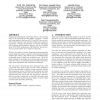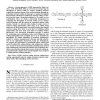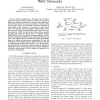156
Voted
WH
2010
14 years 7 months ago
2010
Ubiquitous physiological monitoring will be a key driving force in the upcoming wireless health revolution. Cardiac and brain signals in the form of ECG and EEG are two critical h...
111
click to vote
WH
2010
14 years 7 months ago
2010
The advancement of precision micropower amplifiers, microcontrollers, and MEMs devices have allowed for a paradigm shift from traditionally large and costly health monitoring equi...
138
click to vote
TON
2010
14 years 7 months ago
2010
Abstract--Every congestion control protocol operating in wireless networks is potentially faced with two major challenges of performance degradation. These sources are (a) the coup...
145
click to vote
TON
2010
14 years 7 months ago
2010
A recent approach--COPE, presented by Katti et al. (Proc. ACM SIGCOMM 2006, pp. 243
123
Voted
SIGMETRICS
2010
ACM
14 years 7 months ago
2010
ACM
Laboratory-based mobile wireless testbeds such as MeshTest and the CMU Wireless Emulator are powerful platforms that allow users to perform controlled, repeatable, mobile wireless ...
130
Voted
EJWCN
2010
14 years 7 months ago
2010
Flexbility and deployment simplicity are among the numerous advantages of wireless links when compared to standard wired communications. However, challenges do remain high for wire...
135
Voted
ANCS
2010
ACM
14 years 10 months ago
2010
ACM
Over the past few years, researchers have developed many crosslayer wireless protocols to improve the performance of wireless networks. Experimental evaluations of these protocols...
111
click to vote
TRIDENTCOM
2010
IEEE
14 years 10 months ago
2010
IEEE
Abstract. As wireless networks become a critical part of home, business and industrial infrastructure, researchers will meet these demands by providing new networking technologies....
145
Voted
SENSYS
2010
ACM
14 years 10 months ago
2010
ACM
Passive monitoring is an important tool for measuring, troubleshooting, and protecting modern wireless networks. To date, WiFi monitoring has focused primarily on indoor settings ...
132
Voted
SECON
2010
IEEE
14 years 10 months ago
2010
IEEE
Abstract--Wireless interference is the major cause of degradation of capacity in 802.11 wireless networks. We present an approach to estimate the interference between nodes and lin...







